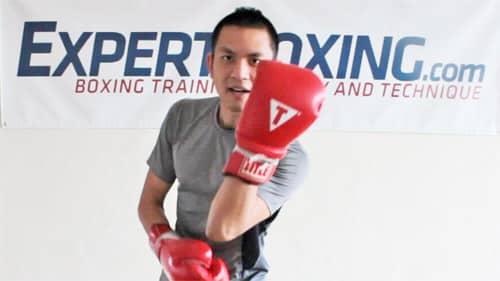
The uppercut is probably the most improperly thrown punch in boxing.
Everybody knows how to throw a sharp jab, and a hard right hand, and killer left hook. But when it comes to uppercuts, oh man…it’s like everybody has their own creative interpretation. If you’ve never been closely adjusted on your uppercut technique by a coach before, there’s a good chance you’re leaving out tons of potential power.
The hardest part about mastering the uppercut
is to disregard the way it looks.
You have to get past the tendencies of dropping the arm, and crouching low, and exploding upwards with the uppercut. And even once you get past these beginner mistakes, you’ll have to adjust a dozen more details before it feels like ‘what the pros do’. It took me at least half a dozen variations by different coaches before I refined my uppercut technique to what it is today. And I’m proud to share those tips with you!
Learn how to get more power out of your uppercut!
Basic Uppercut Technique
1. Basic Stance
Get into your basic boxing stance.
You can throw the uppercut from any stance but for now we’ll stick to a neutral stance. Position yourself for the uppercut the same way that you would for a right cross or left hook.
The COMMON MISTAKE is to try and duck down or bend your knees or drop your hands low to “prepare” for the uppercut.
The uppercut can be thrown from your basic boxing stance,
no preparation or modified positions are necessary.
2. Pivot the Body
The body mechanics of the uppercut will be the same as your other power punches.
- For the left uppercut, rotate your body the same way you would for a left hook.
- For the right uppercut, rotate your body the same way you would for a right right cross.
Your body moves the same way like for a cross or hook, even though your arm is coming with an upwards angle now. The shoulders, hips, leg, and feet, will all pivot the same way. Don’t change anything or visualize the body movement differently just because your hand is going upwards instead of straight (cross) or around (hooks).
The COMMON MISTAKE is to lean back or “pop” upwards with your legs or do weird things with your body because you’re visualizing an upwards momentum.
The only thing that changes for the uppercut
is the angle of your arm, not your body movement.
3. Don’t Shift Weight (During the Uppercut)
BEFORE the uppercut, make a small weight shift to side you’re punching from.
- For a left uppercut, shift more weight to your left foot.
- For a right uppercut, shift more weight to your right foot.
You only need a SMALL weight shift, think 60/40. Shift the weight by moving your head and hips towards the foot. This might seem like basic punching technique except…
The key is NOT to shift weight when you throw the punch. I REPEAT…DO NOT SHIFT WEIGHT…during the uppercut.
- This is an important detail that makes the uppercut technique I teach different from how some other coaches teach the uppercut.
The reason I like to stay on the same leg as the punching arm during the uppercut is because it lets me get UNDER the uppercut and get more leverage out of the punch. By staying on the same side as the punching during the uppercut, I feel like it lets me get my hips, my back, and my punching arm under the uppercut and generates more power this way. So again…what I do is shift to one side and then pivot in place as I dig the uppercut.
This isn’t to say that you can’t or shouldn’t shift weight, it’s that it has a different effect. When you shift weight and switch your weight to the other foot, your uppercut will have less solidity under it and it becomes more of a forward punch than an upwards punch. Basically, the uppercut has less “upwards” power when you shift weight away from the side of the punching arm. Now, shifting weight on the uppercut still has other uses such as setting you up to punch with the other arm, or moving your head to a new position (evasive purposes)…but the bottom line is is has less power than an uppercut that doesn’t shift.
You may have also noticed that this approach to shifting weight can also be applied to left hooks to the body. If you watch pro boxers carefully, you will notice that some of them will lean in and keep their weight forward on the front foot when they dig the left hook to the body rather than shift weight back to their rear foot.
See how Mike Tyson stays on the same foot as the throwing arm when he throws the uppercut? He’s definitely not shifting weight to the other foot. And it’s so much more powerful this way.
Get under the uppercut,
and DON’T shift weight during the punch.
4. Loop the arm.
The arms make a sharp compact loop.
You don’t need to release the fist all the way out or drop the fist before the punch. Remember that the uppercut is a short punch; if you have to reach, you’re probably not in range. Simply relax the arm as you release the uppercut and tighten the hand on impact. Keep your elbows down and your palm facing you throughout the uppercut.
Keep your opponent in view. Your head should not be leaned over or leaned back or moving in a way that makes it hard for you to see your opponent. If anything, keep a small distance between your head and your opponent’s head so that there’s a nice compact space for your arm to travel.
With your elbows down and palms facing you,
release your arm in a fast sharp compact loop.
Common Uppercut Mistakes
UPPERCUT MISTAKE #1 – Dropping the hands
Many beginners will drop their hands for the uppercut. Some will even drop their hand as low as their waist. This movement is completely unnecessary because it doesn’t add any power and only leaves you vulnerable. But not surprisingly, it happens a lot because many people like to visualize the uppercut as going from “down to up”.
In reality, the “release” of the arm will drop the hand enough for the uppercut angle. You don’t need to drop the hand at all. Your arm is already connected to your shoulder. So if you throw your hand at the “natural level”, it is already as low as your shoulder. And if you “relax” your arm a little further, the hand will easily drop to chest level and this is low enough for you to loop upwards into your opponent’s head. Watch my uppercut video and take a close look…I don’t drop my hands very much. Try to keep your hand above your elbow when throwing the uppercut.
Instead of imagining your hand that’s dropping,
imagine your ELBOW is doing the dropping.
UPPERCUT MISTAKE #2 – Letting the hand fly past the opponent
Many beginners will miss wide when their uppercuts don’t land. The reason is because their uppercuts are traveling in a straight motion rather than a looping motion. Remember to visualize a tight compact looping motion with your arms. Even if you’re throwing a long uppercut, make sure you visualize a loop so that your hand returns to you. This visualization not only returns the arm but also adds power.
Throw your uppercuts with a compact loop,
instead of letting your hand fly into the sky.
UPPERCUT MISTAKE #3 – Lifting the elbow
Don’t lift your elbow when you throw the uppercut; it should only be the hand that goes upwards (not the elbow). Keep your elbow down during the uppercut so that you have more stability and leverage in the punch. This will not only give you more power and a more compact uppercut but also helps to keep your hand from flying into the sky when you miss.
You should also make sure your elbow doesn’t lift out the side like a chicken wing. Making sure your palm is facing you will also help to keep the elbow down towards the middle. The elbow can move a little but it needs to be pointing down and preferably not extend past a 90-degree angle (unless you really need a long uppercut).
Keep your elbows down during the uppercut,
for more leverage and power.
UPPERCUT MISTAKE #4 – Lifting your hips
Many beginners will lift their hips and “pop up” with the uppercut because they’re over-visualizing the “UP” in “uppercut”. Again…your hips need to stay down. This will give you more speed and power and ability to throw faster follow-up punches or other follow-up moves. Just as I’ve said before: the only thing going “up” during the uppercut is the hand (and even then, it’s very little), the rest of the body stays down and grounded. If anything your body needs to go DOWN during the uppercut. This will give you more power and leverage.
You can test your technique to see if you’re doing it right by throwing 2 uppercuts in a row from the same hand. If you do it right, you’ll feel like you’re body is going down with each uppercut and it feels like you’re going ‘DOWN, DOWN’ and you’re delivering 2 fast powerful uppercuts.
But if you’re doing it wrong, it’ll feel like your body is popping up with each uppercut and you’ll be going ‘DOWN-UP, DOWN-UP’ which is so much slower. And of course, the DOWN-UP feeling is wrong because it takes you off the ground, decreases balance and power, and slows you down because you can’t make the next move until you’re back down again.
In the past I’ve had many people argue with me because they saw Mike Tyson popping up with each uppercut or other pros popping up with each uppercut. I have 2 explanations for this: 1) the pros are good enough that they know how to stay grounded and send their energy down even when their bodies are going “up”. This is why pros can jump around a lot and still have power and stay grounded whereas beginners only get off balanced and tired quicker. 2) Pros are sometimes jumping up for strategic reasons. And doing that to set something else up. But for sure…when they want power, they stay down. For sure, Mike Tyson can throw 2 powerful uppercuts in a row from the same hand, and you should be able to do the same before moving on to the flashier versions of the move.
A final tip I can give you to help you stay down is NOT to shift weight during the uppercut. Stay on the same leg and if anything, try to drill that leg into the ground. So it’s like you’re pushing yourself INTO the ground rather than pushing yourself OFF the ground. Big difference, ok? 🙂
Go DOWN with the uppercut, not up.
This gives you more power and keeps you ready for the next move.
Power Tips for the Uppercut
1. UPPERCUT TIP #1 – Hips under the uppercut
Keep your hips under the uppercut as much as you can. And you can do this by not letting your upper body lean away from your hips during the uppercut:
- If you’re throwing a left uppercut, keep your upper body and hips over the left foot.
- If you’re throwing a right uppercut, keep your upper body and hips over the right foot.
- Even a slight lean greatly decreases the power.
The common problem is when fighters shift weight during the uppercut. For example: when throwing a right uppercut, many fighters will shift weight to their left foot and what happens is the hips are in the middle and the upper body is over the left foot or even leaning beyond the left foot. The ideal situation would have been for both the hips and upper body to stay over the right foot and the right hand is the only thing that extends out towards the opponent.
Keeping your upper body over the hips, or your hips under your upper body…depending on how you look at it…gives you somuch more power and leverage because you’re adding other joints of support between the ground and your fist. When you the upper body and hips are not stacked on each other, there is a good chance nothing is supporting you’re uppercut from directly underneath and it turns the punch into more of a forwards punching than an upwards punch.
Keep your upper body and hips over the same side.
2. UPPERCUT TIP #2 – Elbows under the uppercut
Try to get your elbow under the uppercut. Remember how I said earlier that beginners lower their hands too much for the uppercut? Well I want you to do the same…but with your elbow. Use your elbow to DIG under the uppercut. Keeping the elbow under gives you more leverage and support for your fist…and definitely adds power to your uppercut.
Use your elbow to dig under the uppercut.
3. UPPERCUT TIP #3 – Big Load, Tight Pop
This is more of a visualization tip to help you see the uppercut in a more powerful way. Visualize yourself loading up a prepping for a big move but in reality, the uppercut is only a very tight compact punch. This way is better than what many beginners do…which is they will load only a tiny bit but then release a wide uppercut.
Visualize yourself prepping for a big uppercut,
but then throw only a tight compact powerful shot.
4. UPPERCUT TIP #4 – Rotate around your back, not your front
This is a tricky visualization to understand but adds tremendous amounts of power to your uppercuts. Many beginners like to visualize the uppercut as rotating around the front of their body. Instead, I want you to visualize the uppercut as rotating aroudn the BACK of your body. This is far more powerful and devastating.
Try to see it like this:
- For a left uppercut – INSTEAD of imagining yourself pulling your left arm across your chest to the other side, TRY to pull your right shoulder around your back towards your left elbow.
- For a right uppercut – INSTEAD of imagining yourself pulling your right arm across your chest to the other side, TRY to pull your left shoulder around your back towards your right elbow.
You may notice that when you think about the uppercut contracting around the BACK of your body, instead of the front of your body, that it keeps your body down instead of letting you pop up with the punch. It can be a very awkward visualization at first but if you keep practicing it, you will see the point where it becomes truly powerful and you’ll start to see other fighters, especially the pros, doing the same thing.
Another way to see this is that since the punch is contracting around your BACK SIDE, then it is your back that is compact during the uppercut and your front is stretched and expanding. This is far different from the norm…which is where most fighters will compact the FRONT of their body (for defensive purposes) and expand the back of their body. I won’t go into the defensive ramifications of this technique but it’s important for you to understand and feel the difference in punching power. I would say this secret is one of my best secrets for maximizing punching power.
Visualize yourself rotating around the back of your body,
instead of the front.
Another visualization tip:
- Imagine yourself contracting your BACK while expanding your FRONT (your chest) when throwing the uppercut.
See how Mike Tyson’s chest is expanded when he throws the uppercut? Most fighters are doing the opposite during the uppercut…which is contracting the FRONT of their body because they’re either trying to rotating around the front of their body or trying to be defensive-minded.
Another way to visualize this…is to imagine that instead of LIFTING the uppercut over your body, you are doing the opposite, which is getting your body UNDER the uppercut.
Check out my other boxing guides on the uppercut:
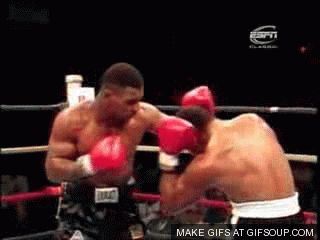
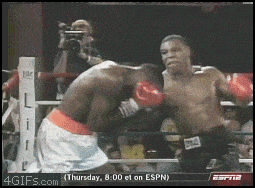






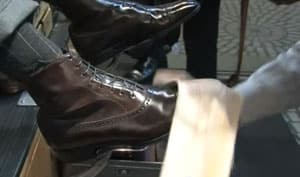
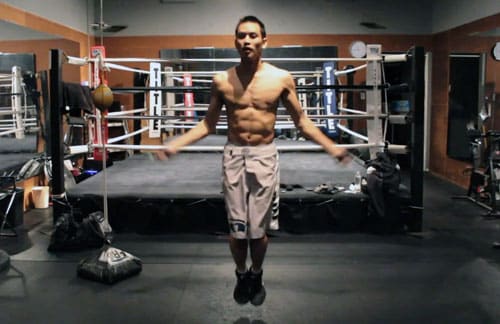



First comment!!!!YEAH
FIRST REPLY, YEAAAAHHHH!!!
Using this technique Floyd hit Alvarez with some clean uppercuts during their fight.Or i’m wrong?
It’s pretty standard technique so yeah, pretty much everyone uses this.
Dont know why but laughed so hard reading this reply
Or you could be like im not sure maaan.. using this technique, Manny Pacquiao hit everyone else with some clean jab. Or i’m wrong?
So when you throw an uppercut, is your body meant to rotate on a slightly tilted axis towards the arm that you are punching with?
Yes, it’s possible to see it that way.
I liked the down down comment on firing off multiple uppercuts as compared to down up down up. You can see in your video just how much faster the combo lands. Going to spend some time on the heavy bag today practicing!
I’m glad you picked out that detail, Ryan! It’s an important one. I hope you feel better with your uppercuts now.
Wow…all your lessons are very useful, but this one is amazing!
I’m glad you like it! 🙂
Hey Johnny man I really like the way u say to line up your elbow with your hip. Great advice. I shadow boxed today and my uppercut punches felt great. I was just wondering do you think I should kind of have that same form with punches like the left hook, jab and right cross? I think u even mentioned that in the advanced workshop. As far as kind of keeping everything aligned.
These techniques are meant for the uppercut only. But some of them can definitely be applied to the left hook and especially the left hook to the body, or shovel hooks. Hope you’re doing well, Patrick!
I don’t understand “UPPERCUT TIP #4”.
It’s just Jack Dempsey’s shoulder whirl. Power is still generated from legs, hips still rotate, but use that rotation to whirl your shoulder backwards in a circular motion. Circular punches will gain great benefit from this. You don’t need to be conscious about front/back contraction/expansion, back shoulder to elbow, and stuff like that. These things only make you think in many more steps than the actual number of steps. Jack Dempsey likes to give simple instructions and say that nature will take care of the rest, which is true if you’re doing it following his instructions. These complicated steps are likely to be noticed from hindsight as “natural occurrences” rather than steps. In other words, the entirety of TIP #4 is basically just the shoulder whirl. Just goddam whirl your shoulder when you throw the punch lol.
Man…I WISH I could get away with only writing 3 sentences like you did. “It’s just a shoulder whirl, th’as all. Do tha shoulder whirl!”
Well we are in very different positions so you have it harder. But actually, I think you would.
Not a chance. I’ve taught people in person and had to explain for a whole 30 minutes to get it through their heads. 3 sentences definitely doesn’t cut it for everyone. Every student is a different kind of learner.
Hello,
again such a good clip/article.
TY :)))
As always, Johnny..Thank you
Thanks for posting this great series on the most misunderstood hand strike of all time, Johnny. I actually laughed out loud at the memory of my first boxing trainer shaking his head as I showed him my idea of a “proper” uppercut. I would crouch down, drop my hands low and LEAP up into the uppercut and drive it skyward as if I were Popeye taking out Bluto! LOL
When he was done shaking his head, he told me something I’ll never forget: “Tran, would like you to hit the pads again with your jab… only turn your fist upside down.” I was completely perplexed and asked him, “You mean you want me to do an upside down jab?!?” He smiled and just said, “Yes.” And that’s how I learned to do a proper long uppercut.
To get me to learn the short uppercut, all he did was step forward into me with the pads when I wasn’t expecting it while I was still “jabbing upside down.” Because I wasn’t expecting it, I instinctively dropped my elbow and leaned back a little without thinking about it in order to connect with the hand pad the same way as before. Voila. Instant proper short uppercut.
That was back in 2006. To this day, my long uppercut is still as fast as my jab and when I’m doing a 1-1 in sparring I will often switch it to a 1-5 and people don’t even realize I’ve done it. My 2-6 is not as good or as fast as my 2-2 but it’s pretty close.
I don’t use them as often as I like, I really should use them more because they really do throw people off completely. I think this is because, interestingly, just as you point out in this series what the most common mistakes attackers make when using the uppercut, I have found that defenders oddly enough anticipate those very same mistakes and then get thrown off by proper uppercut.
One example that happens to me is that on a 1-5 where people are expecting a 1-1 combo and slap my hand twice — which is a normal and proper defense for a 1-1 — only to be surprised that their own hand is coming back at them because my long 5 has pushed their own hand back.
Reading these articles has actually inspired me to force myself to use this great strike more along with more body shots as well. Thanks again for posting.
I LOVE the comment about the upside down fist! Because that’s exactly how I teach the uppercut to beginners. So many of them drop the fist so low.
Hi Jhonny,
I’m a big fan of all your articles and find in your website great advice always, please let me say thanks and well done first of all!!
Secondly I wanted to ask you a question, I’m about to buy a new bag and I’m trying to make up mi mind as I can’t decide if getting an uppercut (t shape) bag, or a normal cylindrical one. Any suggestions? Is the uppercut bag any better? Will be a handicap the fact that is way wider on the top where most of the punches are going?
Thanks a mile and keep it up!
A big fan and supporter,
Seb.
Thank you for the compliments, Sebastian!
The normal cylindrical shape is your best bet. The uppercut bag will be boring and not give you the benefits of the heavy bag such as being able to swing around and let you move around it.
Nice work on the GIFs Johnny. The in-depth videos along with the GIFs with the short breakdowns really helps. Hoping that you keep doing this format in future articles.
Yeah, I like them, too. So much easier than recording a demo of myself against and imaginary opponent. 😉
I love you
i am a beginning boxer at my high school i feel i have lots of potential but know very little about boxing i was wondering what the best moves and techniques are so i can excel in the sport and do what i have wanted to do for a long time.
Hi Johnny, today one of the senior in my class stop me from doing the loop, he said we should kick from the toe and go straight up, nobody do the looping motion, although i feel when i loop the uppercut is faster and stronger and tighter as the hand come back quickly to protect. So i want to ask you if there is any clip or do you any famous boxer who do looping motion with his uppercut so that i can find and show the senior that there are different ways to throw one punch. Thank you 😀
what kind of academic source you refer from? can i know
Thanks a lot Johnny. Your tips are very useful. Please wright same article about straight right( about power etc.)
Thanks for the tips. They were really helpful and scientific.
Johnny, thanks for your tips. I agree that uppercut punch is really complex (as a novice, my other punches are passable, but uppercut is attrocious).
I have the following questions:
1) Which way to throw uppercuts with a step do you prefer? My first coach (Muay Thai guy) taught me to keep the weight on the same-sided leg, punch directly upwards and, if stepping, step with the leg on the same side with punching arm. My current one (boxing) teaches me to shift weight to the opposite leg and punch forward more than up. He punches right on the left step or left on the right step.
2) Do you tilt pelvis (as in, tuck your bottom under your trunk, so that spine becomes C-shaped) while throwing an uppercut?
1. There is more than one way to do things. I suggest you experiment with all of them. Different methods allow for different opportunities and different results. I recommend for you to check out all my articles and videos on the uppercut.
2. I don’t try so hard to tilt the pelvis when throwing the uppercut. (but I imagine some guys do that to stay compact and defensively-responsible). But I do try to keep my hips under me and not to let my upper body lean forward.
We always learned it to throw it upward, pushing off your leg, turning like a corkscrew so you could come back with a strong hook.
Do I have to make whooshing noises too? lol :p great tips.
Any tips for someone with a slight deformity in the arms? I can’t rotate my wrists toward myself, (only as far as facing each other slightly inward) so uppercuts are super awkward for me.
What a great article and videos. I knew my uppercut needed work I could tell wen I hit the pads and bending my legs was way to slow. And surprise surprise all the answers and more are here! Your knowledge of boxing is incredible Johnny and your a diamond for taking the time you do to share it with everyone. Credit to you my friend
Very nice sir thanks
Just a slight typo in the second sentence of the Dropping the Hands paragraph. You said it is “completely necessary.” I believe you forgot the “un-” prefix. Other than that, I loved the content of you article and it really helped me visualize the punch correctly. I do have a question, I’m an orthodox and I always find myself pivoting my hips really far out on my left uppercuts like they’re nearly perpendicular to my target and it leaves my entire side open to some powerful combos. Any advice? I am a beginner though so I’m very limited on the resources at my avail. I have focus mitts, a heavy bag, standard gloves, some speed gloves that work pretty much like wraps and a training partner. Any additional advice to make myself into a better boxer would be much appreciated as well:)
ACKKKK! Thank you so much for this fix, AJ. I can’t believe it sat there for all these years. 🙁
In regards to your concerns about being exposed during your left uppercut, I would preach this mentality (that I ought to make into an article after this): you can’t be in an attacking position AND a defensive position at the same time. Think about your arm…either your arm is PUNCHING (extended & exposing your body) or it is DEFENDING (closed and covering). But you can’t punch AND defend at the same time. Same with your hip…it’s either rotating out and reaching for the shot, or it’s back home and more stable.
With that said, you actually can punch and defend at the same time. First off, you don’t need to move your hips all that much. A powerful little twist and that’s it. In regards to defense, having more movement allows you to be more defensive. Think about it this way….imagine if your head was always in one place when you throw punches vs defend. That would make it vulnerable than if you were to move your head forward during a punch, then backwards to slip away, then forwards for a counter, then to the other side for another follow-up. My point is, any movement that exposes your body somewhere can also be used as a bait and then you move it away while they counter, and then you counter your opponent’s movement instead. (A lot of cat-and-mouse action, right?)
Any extra advice? Read all the guides on my site. Or if you want a shortcut or more structured learning program, can check out my premium guides, like “How to Box in 10 Days”.
thanks you have helped me win my bare knuckle boxing match against callum doyle 🙁